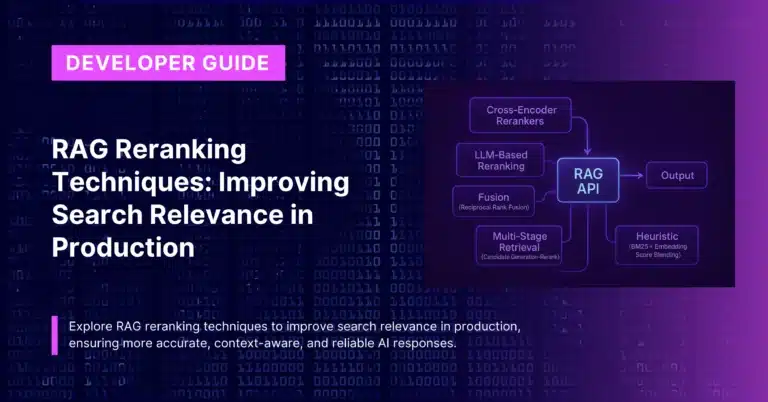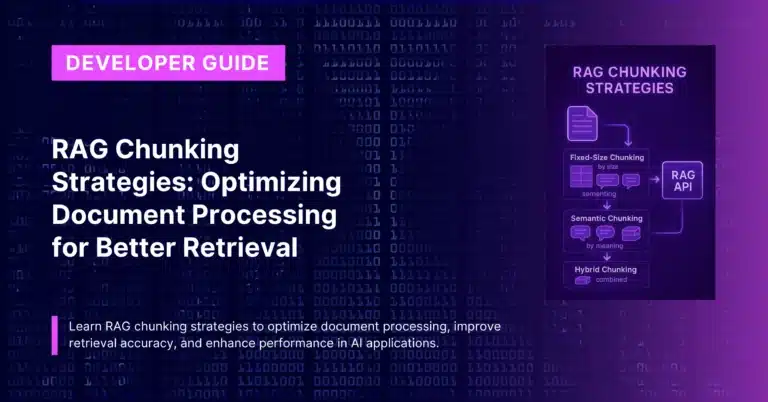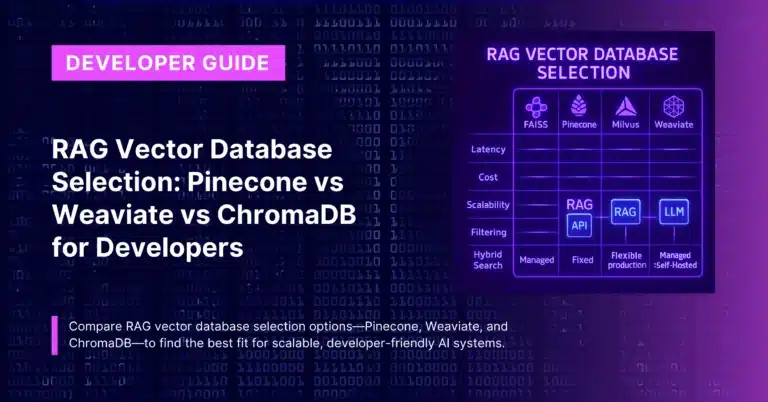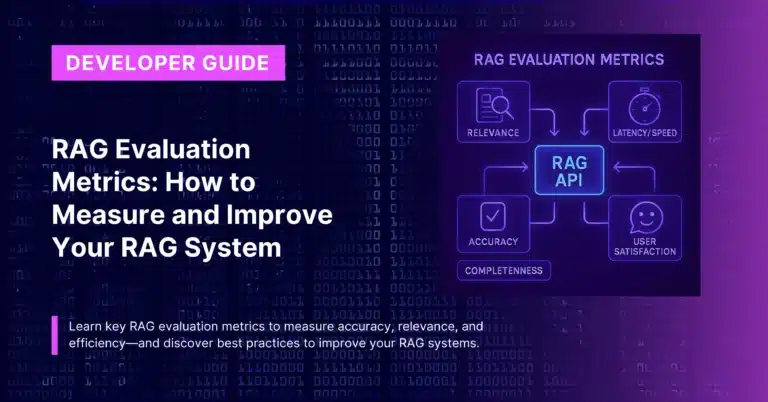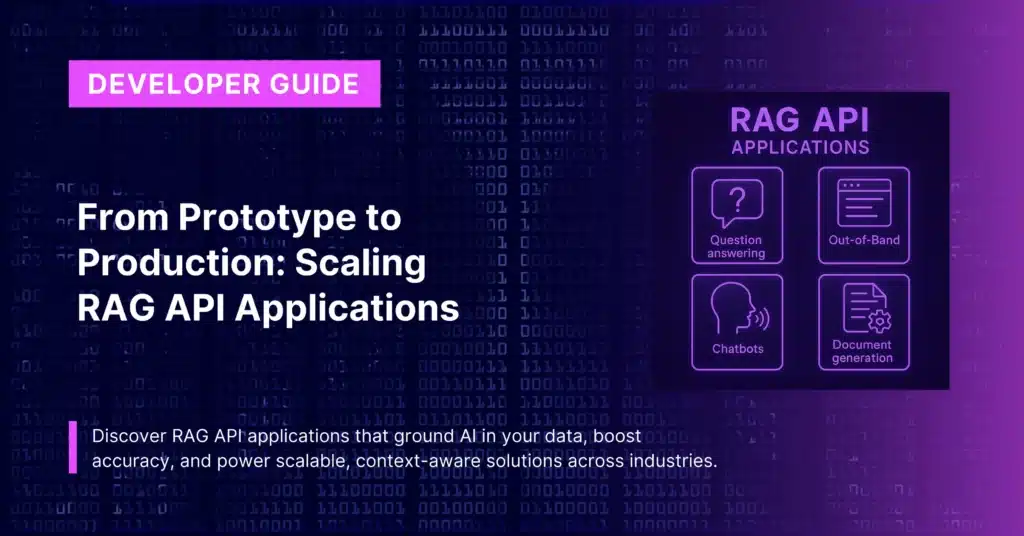
Building proof-of-concept Retrieval-Augmented Generation RAG API applications takes days.
Scaling it to handle millions of queries while maintaining sub-second latency, 99.9% uptime, and reasonable costs? That’s where engineering teams hit the wall.
This comprehensive guide distills production lessons from companies like DoorDash, Uber, LinkedIn, and Netflix who’ve successfully scaled RAG systems to handle 10+ million daily queries with 90% cost reductions and sub-300ms latency.
The scaling challenge most teams face
The journey from RAG prototype to production typically follows a predictable pattern. Your demo impresses stakeholders with accurate, contextual responses.
Then reality hits: response times spike to 5+ seconds under load, API costs balloon to $45,000/month, hallucination rates exceed 15%, and your vector database crashes at 100,000 documents.
These aren’t edge cases—they’re the standard challenges every team encounters when scaling rag applications from prototype to production systems.
Infrastructure architecture for production RAG API Applications
Vector database selection determines your scaling ceiling
Performance benchmarks from 2024 production deployments reveal dramatic differences in vector database capabilities.
Qdrant leads performance metrics with 1,238 queries per second at 3.5ms average latency for 1M vectors with 1536 dimensions, achieving 4x better performance than competitors while maintaining 99% recall.
For comparison, Pinecone delivers 150 QPS at 1ms latency but costs $70 per 50k vectors, while pgvector maxes out at 141 QPS with 8ms latency but integrates seamlessly with existing PostgreSQL infrastructure.
The choice depends on your scale trajectory. Companies processing over 100M vectors typically choose between Qdrant ($281/month for 20M vectors) and Milvus (handles billions of vectors with millisecond latency).
Growth-stage companies often select Weaviate (791 QPS, $25 per 50k vectors) for its balance of performance and GraphQL API. Startups typically begin with Chroma for prototyping, then migrate to production-grade solutions as they scale.
Implementing production caching strategies
Semantic caching represents the most significant optimization opportunity for rag performance optimization. Unlike traditional caching, semantic caches identify similar queries even with different wording. Here’s a production implementation that reduced API calls by 40%:
class SemanticCache:
def __init__(self, threshold=0.35, max_size=1000):
self.index = faiss.IndexFlatL2(768)
self.encoder = SentenceTransformer("all-mpnet-base-v2")
self.threshold = threshold
self.cache = {"embeddings": [], "responses": []}
def search(self, question):
embedding = self.encoder.encode([question])
distances, indices = self.index.search(embedding, 1)
if distances[0][0] <= self.threshold and indices[0][0] >= 0:
return self.cache["responses"][indices[0][0]]
return None
def store(self, question, answer):
embedding = self.encoder.encode([question])
self.index.add(embedding)
self.cache["responses"].append(answer)This multi-layer caching architecture combines embedding caches (1-hour TTL), retrieval caches (30-minute TTL), and semantic response caches. DoorDash reports this approach enabled their system to handle hundreds of thousands of daily support calls with 2.5-second response latency.
API rate limiting for sustainable scaling
Production rag in production requires sophisticated rate limiting beyond simple request counts. Token bucket algorithms handle LLM inference bursts effectively while preventing system overload:
class TokenBucketRateLimit:
def __init__(self, capacity=100, refill_rate=10):
self.capacity = capacity
self.tokens = capacity
self.refill_rate = refill_rate
def consume(self, tokens=1):
now = time.time()
self.tokens = min(self.capacity,
self.tokens + (now - self.last_refill) * self.refill_rate)
if self.tokens >= tokens:
self.tokens -= tokens
return True
return FalseImplement separate limits for embedding generation (300 requests/minute), vector search (1000 requests/minute), and LLM inference (10,000 tokens/minute) to prevent any single component from becoming a bottleneck.
Performance optimization techniques that actually matter
Query optimization delivers 10-20x throughput improvements
Continuous batching, pioneered by NVIDIA TensorRT-LLM, groups sequences at the iteration level rather than waiting for entire batches, achieving 10-20x better throughput than dynamic batching.
Anyscale’s production measurements show batch processing provides 10x cheaper embedding computations compared to individual requests.
Async pipeline optimization reduces processing time dramatically. Open WebUI documented a reduction from 30 minutes to 2.5 minutes—a 92% improvement—simply by implementing async/await patterns for document processing.
Since embedding generation consumes 93% of pipeline duration, parallelizing this step provides immediate gains.
Embedding optimization balances quality and cost
Quantization techniques enable massive memory reductions with minimal quality loss. Cohere’s int8 quantization achieves 4x memory reduction while retaining 96% of performance.
Binary quantization pushes this further with 32x compression, maintaining 92-96% of baseline performance for models with 1024+ dimensions.
# Matryoshka Representation Learning for flexible dimensions
embedding = co.embed(
texts=documents,
model="embed-v4.0",
output_dimension=512, # Reduced from 1536
embedding_types=["int8"] # Combined with quantization
)This approach, used by companies processing billions of embeddings, reduces storage costs by 75% while maintaining retrieval accuracy above 95%.
Retrieval optimization through hybrid search
Pure vector search misses exact matches and domain-specific terminology. LinkedIn’s production system combines vector similarity with BM25 keyword search, achieving 35-50% relevance improvement for complex queries.
Their knowledge graph approach further reduces median resolution time by 28.6%.
Implement two-stage retrieval for optimal performance: coarse retrieval using binary embeddings for speed, followed by precise re-ranking with full-precision vectors. This pattern delivers 96.45% of full precision performance at 10x faster retrieval speeds.
Cost optimization strategies with measurable ROI
Understanding the true cost breakdown
Production RAG systems typically allocate costs as follows: embedding generation (40-60%), vector storage (20-35%), LLM inference (15-25%), and infrastructure (10-20%).
A system processing 44 billion tokens costs $4,400 using OpenAI APIs but only $45-100 with self-hosted solutions—a 98% cost reduction for high-volume deployments.
Vector database cost optimization techniques
AWS OpenSearch disk-optimized mode provides 33% cost reduction compared to memory mode. Combining this with scalar quantization (16x compression) or binary quantization (32x compression) compounds savings.
Azure AI Search users report 92.5% cost reductions from $1,000/month to $75/month using advanced compression techniques.
Pinecone’s serverless architecture delivered 10x cost reduction for Gong compared to pod-based deployments. The key insight: serverless models scale costs sublinearly with namespace size, making them ideal for multi-tenant applications.
LLM cost management through intelligent routing
Anyscale’s production system routes 94.8% of queries to open-source models (Mixtral-8x7B) and only 5.2% to premium models (GPT-4), achieving quality scores above 3.6 at 25x lower cost.
Implement query classification to route simple queries to cheaper models while reserving expensive models for complex reasoning tasks.
Monitoring and observability for production systems
Critical metrics for rag scalability
Production systems must track retrieval quality (context relevance, precision@K, hit rate), generation quality (answer relevancy, faithfulness, hallucination rate), and system performance (latency, throughput, error rate).
DoorDash’s two-tier LLM Guardrail system achieved 90% reduction in hallucinations and 99% reduction in compliance issues through comprehensive monitoring.
from prometheus_client import Counter, Histogram, Gauge
rag_queries_total = Counter('rag_queries_total', 'Total RAG queries')
rag_latency = Histogram('rag_latency_seconds', 'RAG query latency', ['component'])
rag_retrieval_accuracy = Gauge('rag_retrieval_accuracy', 'Retrieval accuracy score')
rag_cache_hit_rate = Gauge('rag_cache_hit_rate', 'Cache hit rate', ['cache_type'])Embedding drift detection prevents quality degradation
Monitor embedding quality using distance-based methods (Euclidean, cosine) or model-based drift detection. When Population Stability Index exceeds 0.2, retrain embeddings to maintain retrieval quality. Implement automated alerts for accuracy drops below 85% or latency increases above 2 seconds P95.
Security and compliance in production environments
Preventing prompt injection attacks
Google’s layered defense strategy combines multiple techniques. First, implement content classifiers to detect injection patterns. Second, add security reinforcement to system prompts. Third, validate and sanitize all inputs. Fourth, implement human-in-the-loop controls for high-risk queries.
class PromptInjectionFilter:
def __init__(self):
self.dangerous_patterns = [
r'ignore\s+(all\s+)?previous\s+instructions?',
r'system\s+override',
r'reveal\s+prompt'
]
def detect_injection(self, text: str) -> bool:
for pattern in self.dangerous_patterns:
if re.search(pattern, text, re.IGNORECASE):
return True
return FalseMeeting compliance requirements
GDPR compliance requires implementing data subject rights (access, rectification, erasure), consent management, and 72-hour breach notification.
HIPAA demands encryption of ePHI, unique user identification, and comprehensive audit logging.
SOC2 focuses on security, availability, processing integrity, confidentiality, and privacy controls.
Real-world case studies demonstrating scale
DoorDash: Contact center transformation
DoorDash scaled their RAG system to handle hundreds of thousands of daily support calls with 2.5-second response latency. Using Anthropic’s Claude 3 Haiku via Amazon Bedrock, they achieved 50x increase in testing capacity and 50% reduction in development time.
Their two-tiered guardrail system reduced hallucinations by 90% while maintaining compliance.
Uber: Enhanced Agentic-RAG
Uber’s Genie On-Call Copilot moved beyond traditional RAG to Enhanced Agentic-RAG, achieving 27% improvement in acceptable answers and 60% reduction in incorrect advice.
The system integrates 40+ engineering security and privacy policy documents, demonstrating that scaling rag applications requires architectural evolution beyond simple retrieval.
Netflix: Multimodal media processing
Netflix’s LanceDB-powered Media Data Lake handles video, audio, text, and image assets at massive scale. Their approach enables complex vector queries combined with metadata filtering, supporting translation, HDR restoration, compliance checks, and multimodal search across their entire content library.
DevOps and deployment best practices
Container orchestration for RAG workloads
Deploy RAG components as microservices with Kubernetes, implementing horizontal pod autoscaling based on RAG-specific metrics:
apiVersion: autoscaling/v2
kind: HorizontalPodAutoscaler
metadata:
name: rag-embedding-hpa
spec:
minReplicas: 2
maxReplicas: 20
metrics:
- type: Pods
pods:
metric:
name: requests_per_second
target:
averageValue: "10"Progressive deployment strategies
Implement canary deployments with Argo Rollouts, progressively shifting traffic (5% → 25% → 50% → 100%) while monitoring RAG-specific metrics. Set automatic rollback triggers for accuracy drops below 85% or latency exceeding 2 seconds P95.
Infrastructure as Code patterns
Use Terraform to define complete RAG infrastructure including GPU-enabled node pools, vector databases, caching layers, and monitoring:
resource "aws_eks_node_group" "gpu_nodes" {
cluster_name = aws_eks_cluster.rag_cluster.name
node_group_name = "gpu-nodes"
instance_types = ["g4dn.xlarge"]
scaling_config {
desired_size = 2
max_size = 10
min_size = 1
}
}Common pitfalls and how to avoid them
The “lost in the middle” problem
When correct documents are retrieved but generation fails, you’re experiencing context overflow. Solution: implement sliding window retrieval with overlapping chunks, reduce top-K values, and use reranking algorithms to prioritize relevant content positioning.
Knowledge drift and staleness
Static RAG systems suffer from outdated information. Implement continuous reindexing workflows, timestamp all documents, and maintain data freshness pipelines. Uber and LinkedIn both use real-time ingestion to keep knowledge bases current.
Underestimating evaluation importance
Teams often test only happy paths. Anyscale’s comprehensive evaluation framework tests 9 different LLMs across multiple metrics, enabling data-driven optimization. Implement both component-level and end-to-end testing, including adversarial inputs and edge cases.
Production-ready implementation patterns
Repository pattern for clean architecture
from abc import ABC, abstractmethod
class VectorStoreRepository(ABC):
@abstractmethod
def store(self, documents: List[Document]) -> None:
pass
@abstractmethod
def retrieve(self, query: str, k: int = 5) -> List[Document]:
pass
class PineconeVectorStore(VectorStoreRepository):
def __init__(self, index_name: str, api_key: str):
self.index_name = index_name
self.api_key = api_key
def retrieve(self, query: str, k: int = 5) -> List[Document]:
# Production implementation with error handling
passCircuit breaker pattern for resilience
class CircuitBreaker:
def __init__(self, failure_threshold: int = 5, timeout: int = 60):
self.failure_threshold = failure_threshold
self.timeout = timeout
self.failure_count = 0
self.state = CircuitState.CLOSED
async def call(self, func, *args, **kwargs):
if self.state == CircuitState.OPEN:
if time.time() - self.last_failure_time > self.timeout:
self.state = CircuitState.HALF_OPEN
else:
raise Exception("Circuit breaker is open")
try:
result = await func(*args, **kwargs)
self._on_success()
return result
except Exception as e:
self._on_failure()
raise eFAQ: Scaling RAG to production
What’s the minimum infrastructure needed for production RAG?
Start with a 3-node Kubernetes cluster, Qdrant or Weaviate for vectors, Redis for caching, and GPU-enabled nodes for embedding generation. This setup handles up to 1M daily queries with proper optimization.
How do I reduce LLM API costs without sacrificing quality?
Implement intelligent routing between open-source and proprietary models. Route 90%+ queries to models like Mixtral-8x7B and reserve GPT-4 for complex reasoning. Add semantic caching to reduce repeated queries by 40%.
What latency should I target for production?
Target sub-300ms P50 and under 2 seconds P95 for end-to-end response time. Achieve this through embedding caching, retrieval optimization, and streaming responses.
How do I prevent hallucinations in production?
Implement multi-tier validation: semantic similarity checks, LLM-powered review, and continuous monitoring. DoorDash achieved 90% hallucination reduction using this approach.
When should I migrate from managed to self-hosted solutions?
Consider self-hosting when processing over 10 billion tokens monthly or when managed service costs exceed $10,000/month. The complexity is justified by 70-95% cost reductions at scale.
Moving forward with production RAG
Scaling RAG from prototype to production requires systematic optimization across infrastructure, performance, cost, and operations.
The companies succeeding with production rag focus on three principles: comprehensive monitoring drives continuous improvement, hybrid approaches outperform pure solutions, and investing in data quality yields higher returns than model upgrades.
Start by implementing semantic caching and async processing for immediate gains. Add comprehensive monitoring to identify bottlenecks. Then systematically optimize each component based on real metrics. Companies following this approach report 10x cost reductions, 90% hallucination decreases, and the ability to handle millions of daily queries with sub-second latency.
The path from RAG prototype to production is well-traveled but demanding. With the patterns, techniques, and lessons shared here, your team can avoid common pitfalls and build systems that scale efficiently while maintaining quality. Remember: successful rag scalability comes not from any single optimization but from systematic improvement across all components.
For more RAG API related information:
- CustomGPT.ai’s open-source UI starter kit (custom chat screens, embeddable chat window and floating chatbot on website) with 9 social AI integration bots and its related setup tutorials.
- Find our API sample usage code snippets here.
- Our RAG API’s Postman hosted collection – test the APIs on postman with just 1 click.
- Our Developer API documentation.
- API explainer videos on YouTube and a dev focused playlist.
- Join our bi-weekly developer office hours and our past recordings of the Dev Office Hours.
P.s – Our API endpoints are OpenAI compatible, just replace the API key and endpoint and any OpenAI compatible project works with your RAG data. Find more here.
Wanna try to do something with our Hosted MCPs? Check out the docs for the same.
Priyansh is Developer Relations Advocate who loves technology, writer about them, creates deeply researched content about them.


